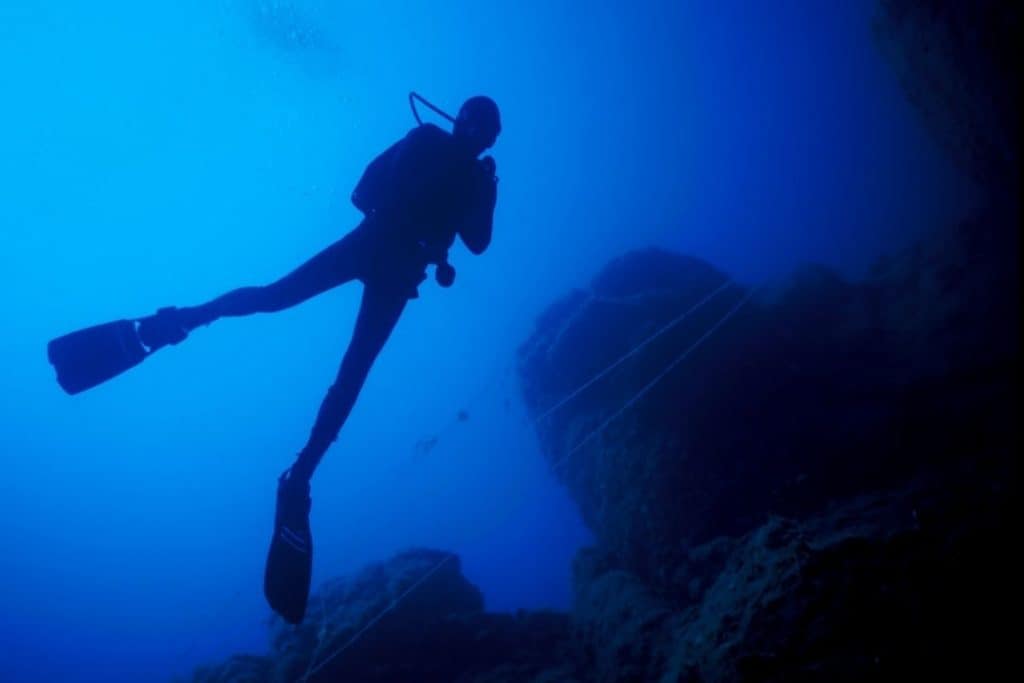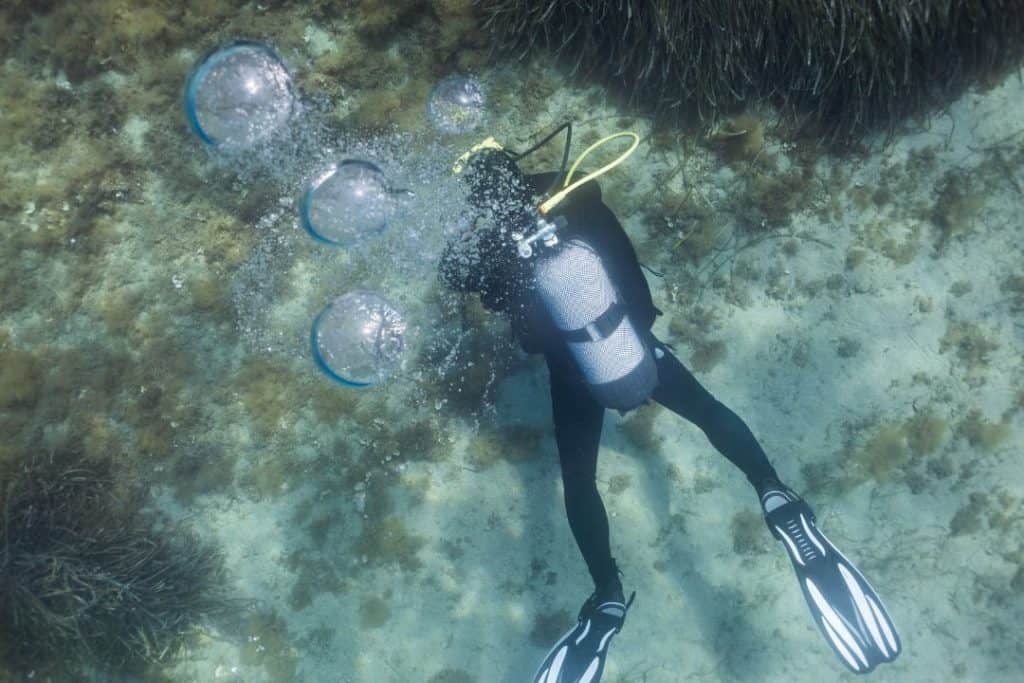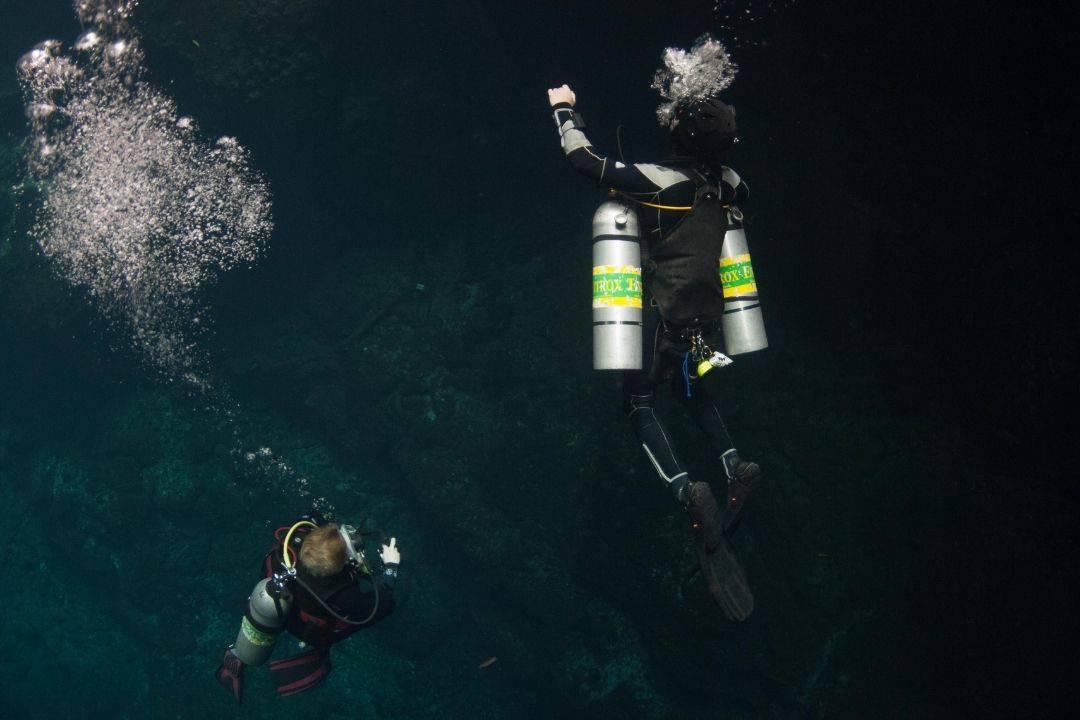How deep can you go with Enriched Air Nitrox (EAN) is often misunderstood by those who have yet to be trained to dive with it.
While often called a deep dive gas because it can extend bottom times when compared to air dives, it has limits. Oxygen is essential to life, however, too much can lead to oxygen toxicity. It does not take much exposure before we will experience it.
As an example breathing 100% oxygen in just 20 feet (ca. 6 m) of water for a few minutes may cause your body to go into convulsions. The lower the percent of oxygen the deeper we can go before we reach oxygen toxicity.
Using 21% oxygen, which is normal for the air we breathe, we do not reach a danger threshold till over 200 feet (ca. 61 m). That is well beyond the limits of recreational diving. One of the requirements of diving with EAN is to determine the percentage of oxygen in your cylinder and calculating the Maximum Operating Depth (MOD).
How deep can you scuba dive with Enriched Air Nitrox ?
You can dive as deep as 112 feet (ca. 34 m) with 32% Nitrox and 95 feet (ca. 29 m) with 36% Nitrox. There are special tables to find out max depth limits according to the EAN oxygen percentage.
Enriched Air Nitrox Depth Limits and Oxygen Toxicity.

Oxygen toxicity is a very complex medical topic. Fortunately, there are only a few easily understood key points that EAN divers must know and apply to their dive planning. There are two forms of oxygen toxicity:
- Pulmonary oxygen toxicity which can happen with prolong exposure of high percentages of oxygen. This is mostly a concern in a hospital where a patient receives oxygen for more than a day.
- However, repetitive technical divers using a high concentration of oxygen under pressure will need to take this concern seriously as well. One layman way of looking at this would be to say that the diver must off gas the extra oxygen in a manner similar as they off gas the extra nitrogen.
- Central Nervous System (CNS) oxygen toxicity which can happen with even short exposure of oxygen at a high partial pressure. Referred to as PO2. The PO2 in your body is determined by the percentage of oxygen you are breathing times the amount of pressure the breathing gas is under.
Enriched Air Nitrox MOD will keep the PO2 levels in the safe range.
Avoiding Central Nervous System (CNS) Oxygen Toxicity

In the 1970s, the National Oceanic and Atmospheric Administration (NOAA) introduced the concept of oxygen-enriched air diving. They created a breathing gas mix with 32% oxygen calling it NOAA Nitrox 1.
This mix allowed a maximum operating depth of 130 feet (ca. 40 m) and a maximum oxygen partial pressure of 1.6 atmospheres absolute (ATA), also noted as PO2 of 1.6.
The maximum oxygen partial pressure of 1.6 atmospheres absolute (ATA) was considered the highest partial pressure that would be safe before the possible onset of CNS toxicity symptoms.
Diving on 21% air, this level would not be reached until about 220 feet (ca. 67 m), however, on Nitrox I it was reached at 130 feet (ca. 40 m). As we increase the oxygen content of the breathing gas, the depth becomes shallower.
When EAN became more wide spread in recreational diving, the PO2 of 1.4 became the safe level for planning the dives. Avoiding Central Nervous System (CNS) Oxygen Toxicity is simply a matter of keeping our PO2 below 1.4.
CNS toxicity symptoms can be remembered using the acronym CON-VENTID.
- CON – Convulsions. Convulsions themselves are not necessary dangerous, however, underwater it is highly likely you will lose your regulator and be unable to retrieve it.
- V – Visual disturbances. This can range from tunnel vision to blurring.
- E – Ears. A ringing in the ears or other auditory disturbances.
- N – Nausea. Intermittent or constant, and can also lead to lost of your regulator or material in your lungs.
- T – Twitching. Most noted in the facial muscles.
- I – Irritability. Any kind of character change.
- D – Dizziness. Feeling confused, or a sense of vertigo.
Calculating Enriched Air Nitrox Depth Limits

The breathing gases EAN-32 and EAN-36 are the most commonly used and Nitrox dive tables will show the Maximum Operating Depth for these:
| Oxygen Percentage | Maximum Operating Depth (ft.) | Contingency Depth (ft.) |
|---|---|---|
| 21% | 186 | 218 |
| 22% | 177 | 207 |
| 23% | 167 | 196 |
| 24% | 159 | 187 |
| 25% | 151 | 178 |
| 26% | 144 | 170 |
| 27% | 138 | 162 |
| 28% | 131 | 155 |
| 29% | 126 | 149 |
| 30% | 121 | 143 |
| 31% | 116 | 137 |
| 32% | 111 | 132 |
| 33% | 107 | 127 |
| 34% | 102 | 122 |
| 35% | 99 | 117 |
| 36% | 95 | 113 |
| 37% | 91 | 109 |
| 38% | 88 | 105 |
| 39% | 85 | 102 |
| 40% | 82 | 99 |
| 41% | 79 | 95 |
| 42% | 76 | 92 |
| 43% | 74 | 89 |
| 44% | 72 | 87 |
| 45% | 69 | 84 |
| 46% | 67 | 81 |
| 47% | 65 | 79 |
| 48% | 63 | 77 |
| 49% | 61 | 74 |
| 50% | 59 | 72 |
However, you will often find other percentages when you test your dive tanks. In those cases, you may have to calculate the MOD yourself.
The MOD formula for feet in salt water looks more intimidating than it really is.
The MOD (feet) is 33 feet x [(PO2/FO2)-1]. PO2 is the desired partial pressure in oxygen and the FO2 is the decimal value of the fraction of oxygen in the mixture. For example, if a tank contains 32% oxygen and the maximum PO2 is 1.4 ATA, the MOD (feet) is 33 feet x [(1.4 / 0.32) – 1] = 111 feet.
To obtain a MOD in meters, we just use 10 meters instead of 33 feet. For example, if a gas contains 32% oxygen and the maximum PO2 is 1.4 bar, the MOD (meters) is 10 meters x [(1.4 / 0.32) – 1] = 33.7 meters.
It is standard procedure for a diver to independently verify the oxygen content of their cylinders, calculate the MOD, record their findings in a log and to mark the cylinder with the MOD.
When using a dive computer, the diver will enter the oxygen percentage into the computer before stating the dive.
It Nitrox Worth The Extra Step
The talk of oxygen toxicity may put you off EAN at first. However, look past that. When you first started to learn to dive, DCS was a major concern. It did not take you long to understand it and learn how to control the risk.
When diving with an EAN mix, we need to consider the risk of oxygen toxicity. However, with training, you will see that it is a risk that is clearly understood and easy to manage.
A few extra minutes of preparation can lead to a much longer dive.
If you have any questions or comments, feel free to add them.



Thank you so much for this very valuable resource. It was very informational and helped me get a better understanding of depth calculations for certain oxygen mixes.
I’m new in the diving field and i’ve been wondering what NITROX is all about. so thanks for enlightening me